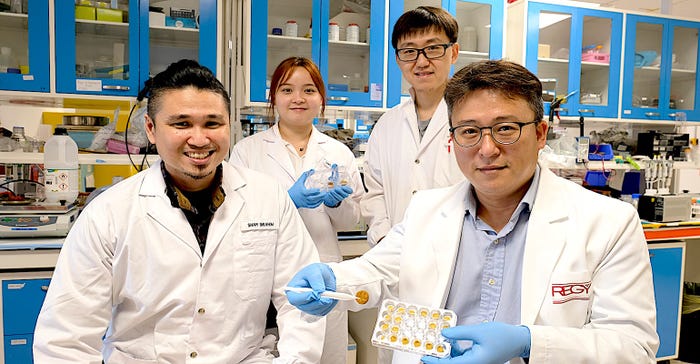Researchers in Singapore use natural materials like pollen to create a new solution to help clean up oil spills.
May 19, 2021

Researchers in the United States have already invented a sponge that can be used as a novel solution to soak up contaminants in water. Now researchers in Asia have put an environmentally friendly twist on this type of invention with a sponge made of sunflower pollen that shows promise for use to soak up oil spills.
Researchers from Nanyang Technological University (NTU) Singapore and Sungkyunkwan University in South Korea have collaborated to create the hydrophobic sponge, which they said can absorb oil contaminants of various densities, including gasoline and motor oil, at a similar rate to commercial absorbent materials commonly used to soak up spills.
More importantly, perhaps, is the fact that the sponge is made from natural materials, so it doesn’t add any new chemical agent into an already contaminated area, and also is cheaper to produce, researchers said.
“By finetuning the material properties of pollen, our team successfully developed a sponge that can selectively target oil in contaminated water sources and absorb it,” said Professor Cho Nam-Joonfrom from the NTU School of Materials Science and Engineering, who led the research. “Using a material that is found abundantly in nature also makes the sponge affordable, biodegradable, and eco-friendly.”
The sponge’s capability comes primarily from a coat of natural fatty acid researchers applied to the sponge, which itself is comprised of sunflower pollen, which the team already has used to create new materials for various purposes.
Last year, for example, the team created a paper-like material from pollen as a more environmentally sustainable alternative to paper created from trees. The paper also bends and curls in response toc hanging levels of environmental humidity, expanding its application to other uses in soft robots, sensors, and artificial muscles.
“Pollen that is not used for plant pollination is often considered biological waste,” Nam-Joonfrom explained in a press statement. “Through our work, we try to find new uses for this ‘waste’ and turn it into a natural resource that is renewable, affordable, and biodegradable.”

Creating the Sponge
Pollen is known as the diamond of the plant kingdom for its hard exterior. To form the sponge, the team transformed this into microgel particles through a chemical process akin to conventional soap-making. Specifically, the process includes removing the sticky oil-based pollen cement that coats the grain’s surface, after which researchers incubated the pollen in alkaline conditions for three days.
The resulting gel-like material was then freeze-dried, resulting in the formation of pollen sponges with 3D porous architectures, researchers said.
Finally, researchers briefly heat the sponges to 200 degrees Celsius, which is what gives them their stable structure enabling them to repeatedly absorb and release liquids. Heating also improved the sponge’s resistance to deformation, they said.
Once the sponge itself was formed, researchers coated it with a layer of stearic acid, a type of fatty acid found commonly in animal and vegetable fat. This ensured the sponge would remain hydrophobic and target oil and not water for its absorption capability, researchers said.
Researchers published a paper on their work in the journal Advanced Functional Materials.
Performance and Future Uses
So far, the researchers have engineered sponges that measure 5 centimeters (cm) in diameter, which obviously would have to be scaled up to tackle the problem of absorbing oil in oil spills. They tested these sponges for potential performance in real-world scenarios, with promising results, they said.
The team conducted three specific tests to this end. First, they used the pollen sponge to absorb a range of oils and organic solvents of varying densities, such as gasoline, pump oil, and n-hexane, a chemical found in crude oil. Results showed that sponge had an absorption capacity in the range of 9.7 to over 29.3 g/g--comparable to petroleum-based commercial polypropylene absorbents used in oil spills, which have an absorption capacity range of 8.1 to 24.6 g/g.
The sponge also showed durability and reusability in tests in which scientists repeatedly soaked it in silicone oil, then squeezed it out. The sponge could perform well for at least 10 cycles, researchers said.
Finally, the team tested the ability of a sponge 1.5 cm in diameter and 5 millimeters in height to absorb motor oil from a contaminated water sample, finding that the sponge could absorb the oil in less than two minutes.
Researchers envision various other uses for the sponge and other pollen-based materials due to pollen’s biocompatibility, Nam-Joonfrom said. “It does not cause an immunological, allergic or toxic reaction when exposed to body tissues, making it potentially suitable for applications such as wound dressing, prosthetics, and implantable electronics,” he said in a press statement.
Next steps for the research are to scale up the size of pollen sponges and to collaborate with non-governmental organizations and international partners to conduct pilot tests that use the sponge in real-world environmental scenarios, Nam-Joonfrom added.
Elizabeth Montalbano is a freelance writer who has written about technology and culture for more than 20 years. She has lived and worked as a professional journalist in Phoenix, San Francisco, and New York City. In her free time, she enjoys surfing, traveling, music, yoga, and cooking. She currently resides in a village on the southwest coast of Portugal.
About the Author(s)
You May Also Like



